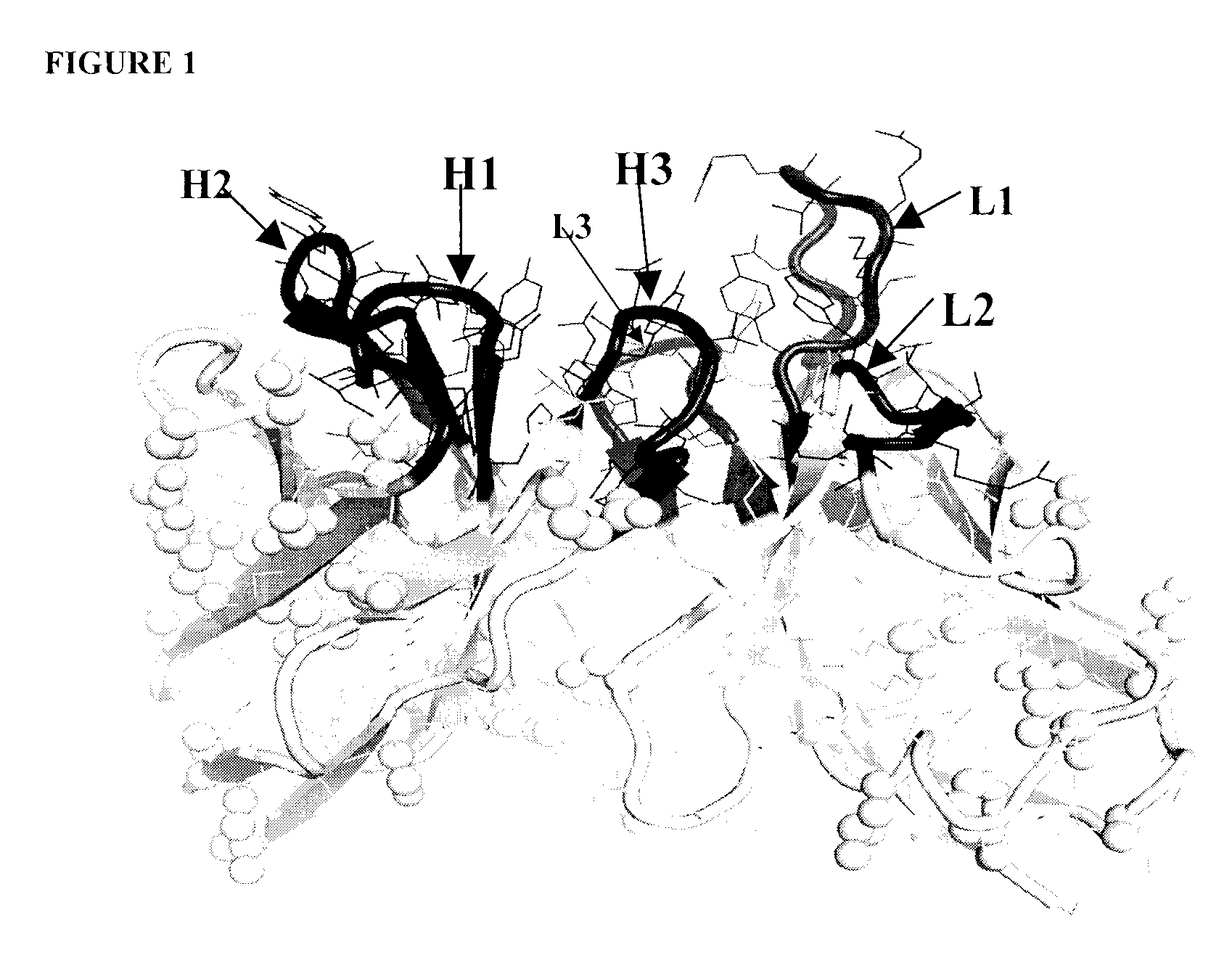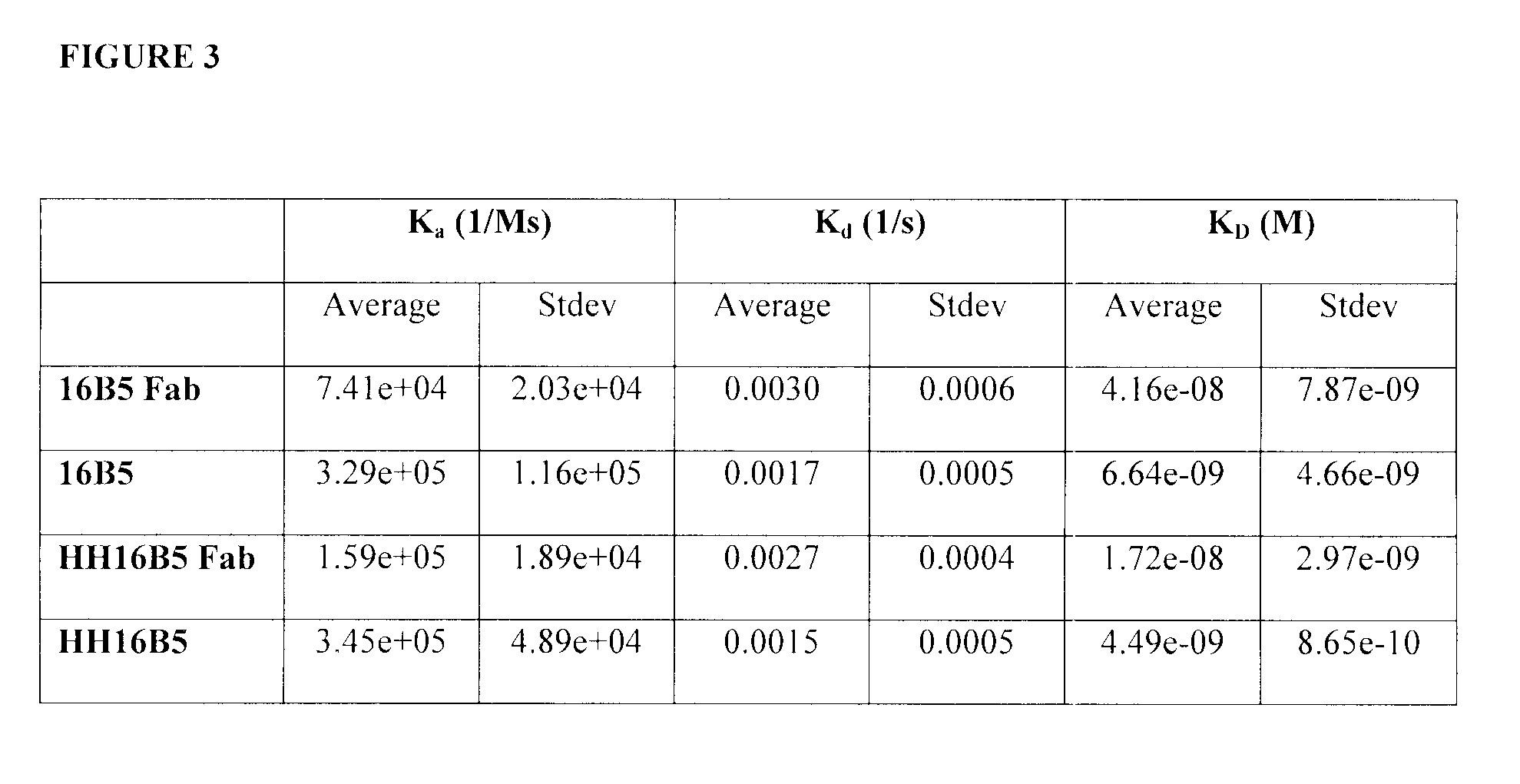Anti-clusterin antibodies and antigen binding fragments and their use to reduce tumor volume
an antibody and antigen technology, applied in the field of anti-clusterin antibodies and their use to reduce tumor volume, can solve the problems of risky direct inhibitors of tgf-, and achieve the effect of reducing tumor volume and inhibiting epithelial-to-mesenchymal transition
- Summary
- Abstract
- Description
- Claims
- Application Information
AI Technical Summary
Benefits of technology
Problems solved by technology
Method used
Image
Examples
example 1
Humanization by Design of the Anti-Clusterin Mouse Monoclonal Antibodies
3D Modeling of the Variable Regions of the Mouse 16B5 Monoclonal Antibody.
[0454]This task was readily accomplished by mutating 3 light-chain residues and 7 heavy-chain residues in the available crystal structures of two different mouse antibodies (Protein Data Bank (PDB) codes 1Q9Q and 1TY7, respectively) followed by assembly of the light and heavy chains by superimposing the template structures. Part of the CDR-H3 loop was based on another antibody structure (PDB code 1UJ3, a humanized antibody) that also has high sequence similarity to the heavy chain of 16B5 but, unlike the mouse template structure, displays the same length for the CDR-H3 loop. The resulting structure was refined by energy minimization with the AMBER force-field and then used in the subsequent analysis. A good quality of the resulting homology model is expected in this case, given the high homology of the mouse 16B5 sequence to available stru...
example 2
Kinetic Analysis of Anti-Clusterin Antibodies
[0460]The purpose of these investigations is to determine the kinetics parameters of anti-clusterin antibodies. In particular, to determine whether the humanization of the 16B5 and 21B12 anti-clusterin monoclonal antibody affects the kinetics parameters of its binding to human clusterin. To this end, a kinetic analysis method was developed using the BIAcore 3000. Human clusterin was immobilized on a sensor chip. Full length antibodies or Fab fragments were injected and allowed to interact with the immobilized clusterin. This example described the exemplary antibody 16B5 but the 21B12 exemplary antibody was prepared and tested in a similar manner.
Immobilization of Clusterin
[0461]HBST (10 mM Hepes pH 7.4, 135 mM NaCl, 3.4 mM EDTA, 0.005% Tween 20) was used as running buffer for all BIAcore experiments. Recombinant monomeric clusterin was immobilized on a CM3 chip with normal amine coupling method at a flow of 5 μl / min. Surface was activated...
example 3
Biological Activity of h16B5 in Cell Based Assays
[0469]These studies were conducted to compare the biological activity of h16B5 with that of the mouse 16B5. To test the h16B5, two assays were used that had previously shown that blocking clusterin with a monoclonal antibody could reduce the migration and invasion of cancer cell lines.
[0470]To test the activity of anti-clusterin antibodies against cancer cell migration, a standard wound healing, or scratch assay, was used. In this assay, EMT6 cells, a mouse mammary carcinoma cell line, was plated at high density and subjected to wounding by the creation of a scratch in the cell layer. At time 0, a wide denuded area is evident that quickly fills up after incubation of the cells at 37 C for 15 h (see upper left-hand panels in FIG. 4). Incubation of the cells in the presence of either a commercial anti-clusterin polyclonal (C-18, Santa Cruz Biotech, Santa Cruz, Calif.) or the mouse 16B5 purified from the original hybridoma resulted in a ...
PUM
| Property | Measurement | Unit |
|---|---|---|
| concentration | aaaaa | aaaaa |
| pH | aaaaa | aaaaa |
| pH | aaaaa | aaaaa |
Abstract
Description
Claims
Application Information
 Login to View More
Login to View More - R&D
- Intellectual Property
- Life Sciences
- Materials
- Tech Scout
- Unparalleled Data Quality
- Higher Quality Content
- 60% Fewer Hallucinations
Browse by: Latest US Patents, China's latest patents, Technical Efficacy Thesaurus, Application Domain, Technology Topic, Popular Technical Reports.
© 2025 PatSnap. All rights reserved.Legal|Privacy policy|Modern Slavery Act Transparency Statement|Sitemap|About US| Contact US: help@patsnap.com



